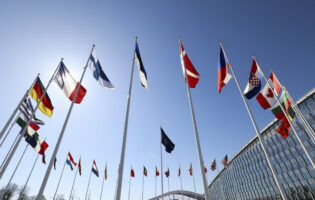Regional Institution-Building in Asia: Are There Any Lessons from Europe?
For many in the international media and among casual observers of Asia, regional institution-building may appear a mundane subject. Strengthening existing regional institutions, or establishing a more substantive one, is generally a matter of secondary importance for policymakers in most capitals in Asia. This is more so in Washington, despite its founding member status in some key Asian institutions. Such a generally perceived insignificance notwithstanding, regional institution-building in Asia has gone through, over the past two decades, a steady, if not flashy, expansion in both size and scope.
Starting with the creation of a mega Asia-Pacific institutional framework, first the Asia Pacific Economic Cooperation (APEC) forum and then the Association of Southeast Asian Nations (ASEAN), Regional Forum (ARF), in the early post-Cold War years, Asia has witnessed the proliferation of intergovernmental arrangements to collectively address regional challenges. The first exclusively East Asian institution, ASEAN plus Three (APT), emerged around the turn of the new millennium, bringing together China, Japan, South Korea, and ten ASEAN countries to cooperate on regional financial management, while a slightly wider East Asian framework, the East Asian Summit, was established in 2005 among sixteen countries—the APT member countries plus Australia, New Zealand, and India—later joined by the U.S. and Russia. At the sub-regional level, ASEAN, the sole substantive regional institution created during the Cold War, has grown considerably in size and depth, whereas in northeast Asia, long viewed as a hostile place for regionalism, three northeast Asian countries—China, Japan, and South Korea—have held trilateral summit meetings since 1999, and established, in 2011, the first inter-governmental organization among themselves, flatly termed the Trilateral Cooperation Secretariat, in Seoul, to promote cooperative activities.
In terms of issue-specific regional institutions, the above-noted APT countries set up, in 2010, a multilateral reserve pooling arrangement totaling $120 billion, named Chiang Mai Initiative Multilateralization (CMIM), to help with managing regional financial crises, introducing a weighted voting procedure—for the first time for Asian-oriented regional institutions—for lending decisions. In the meantime, sixteen Asian countries in 2004 concluded “the Regional Cooperation Agreement on Combating Piracy and Armed Robbery against Ships in Asia” (ReCAAP) that institutionalized multilateral information sharing and other technical cooperation to address growing maritime piracy problems in the region. Furthermore, ministerial meetings of Asian countries have been increasingly regularized and expanded in scope ranging from foreign and economic ministers to environmental and defense ministers. And negotiations for two separate region-wide free trade agreements—the Regional Comprehensive Economic Partnership (RCEP) composed of East Asian countries plus Australia, New Zealand, and India, and the Trans-Pacific Partnership (TPP), of which membership is broader pan-Pacific (including the U.S.) but conspicuously selective—are currently underway.
For the longtime watchers of Asian international relations, these developments are certainly noteworthy. Given that, until the beginning of the 1990s, East Asia was commonly viewed as a barren place for regional institution-building, these new regional arrangements and groupings signify a certain break from the past and prevailing practice of intra-regional management in Asia. They have contributed, according to their proponents, to regional stability, by serving as the confidence-building measures and socialization mechanism for Asian countries. In the meantime, it is no secret that these relatively new regional institutions in East Asia have been the target of constant criticism and persistent skepticism as being ineffectual in solving problems and incapable of changing, or shaping, the behavior of member states, hence proving to be merely a “talk-shop,” or a little less contemptuously, a diplomatic arena for bilateral meetings and power politics between major powers. Their institutional characteristics, such as consensus-based decision-making, soft institutionalism (e.g., a very small secretariat, few legally-binding agreements), and the strictly-upheld principle of state sovereignty—often referred to as the ASEAN, or Asian, Way—are, in the eyes of those same critics, both the sources and manifestations of the problems facing Asian-oriented regional institutions to be more effective and politically significant.
Almost inevitably, much scrutiny of Asian regional institutions has been undertaken in comparison—explicitly or implicitly—with their counterparts in Europe. The record of regional institution-building in Europe has been unprecedented and unrivaled in scale, scope, and substance. Although the 2009 euro crisis struck a serious blow to the EU, festering a growing pessimism in decades-long grand regional endeavors, no one would question the role of European institutions for bringing stability to the region and fostering regional cohesiveness, or a sense of common identity among their citizens. For students of regional institutions and integration, Europe is almost always treated as the exemplar, and Asian institutions are generally found standing at the opposite end of the spectrum—weak, underdeveloped, ad-hoc, and fragmented. Discussions on Asian institutions in this context, particularly in their early years, commonly conclude with policy prescriptions and proposals designed to push Asian institution-building, probably only a little bit, toward the European model. And this may all make sense from the European point of view.
Yet, at the same time, many Asian specialists have come to agree that it is highly unlikely for regional institution-building in Asia to follow the European path, at least for the foreseeable future. Some political leaders in the region went even further and boasted that the Asian way of regional institution-building has been manifesting itself; Asia will pursue its own model, not the European version.
Such perspectives are attributed to some stark differences, in both structural conditions and contingent historical circumstances, between Europe and Asia in their early years of institution-building. In Europe in the 1950s and 1960s, there existed a set of structural factors at the international/regional level (the fragmented world economy, the Cold War international order, and Western Europe’s relatively small geographical size and cultural homogeneity) and the national level (the declining national economy, the need to develop a modern welfare system, and the growing importance of the agriculture sector in a national economic policy) that together induced political leaders of Western European countries to recognize regional integration as desirable and necessary. These structural inducements were not in place in East Asia, when the region finally engaged in institution-building projects; for instance, the world economy in the early 1990s was far more open and integrated than in the 1950s, and therefore, Asian countries saw regional integration for market opportunities as less pressing and crucial than their European counterparts four decades ago. Nor has Asia been, thus far, blessed with any significant contingent factors equivalent to those in Europe—such as entrepreneurial political leadership (e.g., Robert Schuman and Konrad Adenauer) and the transnational network of Christian Democrats in key member states—that would have drastically advanced its institution-building and integration agendas.[1]
So, are European experiences irrelevant for Asian institution-building? In consideration only from the context of organizational designs and decision-making mechanisms, the answer is probably “Yes,” at least in the medium term. Yet, if we look more closely at the achievements of European cooperation, there still exist some useful lessons that Asia can draw from Europe. Here, four particular lessons are identified in two separate areas: (1) issue focuses for multilateral cooperation, and (2) national strategy toward regional institution-building.
Lesson 1: Regionalizing Student Exchange
The first lesson comes from the EU’s long-running, flagship student exchange program, commonly know as the ERASMUS program. Established in 1987 and named after the well-travelled Dutch philosopher Desiderius Erasmus, the ERASMUS program (also read as European Regional Action Scheme for Mobility of the University Students) has enabled over 3 million European students to study in another European country over the past twenty-five years. Last year alone, more than 200,000 students participated in exchange study programs, with more than 4,000 higher education institutions participating across thirty-three countries. Praised as one of the most successful European projects, clearly reflected in its popularity and its steady expansion in size and scope, the program is known to have helped to create the first generation of young “Europeans” with a shared European identity, not to mention that more than a quarter of ERASMUS students met their long-term partner during their study abroad, with an estimated 1 million babies born to ERASMUS couples.[2] In Asia, assisting youngsters to interact across national borders, and in the long run, to forge a sense of community—or a regional identity—among themselves, now appears imperative. This is because Asia currently suffers growing political tensions over territorial disputes, historical issues, or competition for regional dominance between national capitals across the region, while nationalist sentiments are rapidly brewing among the general population, particularly in northeast Asia. This worrisome downtown trajectory needs to be countered in a comprehensive manner, and targeting future generations of Asia is surely an important practical measures with keen foresight.
To be sure, there have been various student exchange and study-abroad programs between Asian countries. But they are almost always on a bilateral basis and often in the form of development assistance and promote only a one-way direction. Although Asian countries finally moved forward, in the past few years, to create an Asian version of ERASMUS, the process has been, thus far, conspicuously fragmented (currently, at least three separate schemes are in place: one among ASEAN countries; another among China, Japan, and South Korea; and the third one among APT countries), tepid, and incremental, with small and sometimes zero, pooled funding, they often rely on ad-hoc arrangements among only a handful of elite universities in each country. To realize an Asian ERASMUS program that would make a real impact, more focused and centralized efforts are necessary to scale up the program, to streamline procedures to increase accessibility, and to regionalize the scheme in a substantive manner. In this sense, the Asian ERASMUS project should become an urgent priority for regional cooperation, and accordingly, regional institutions—be they existing or new—should be designated a central role in undertaking this major, long-term regional project.
Lesson 2: Sustained Historical Dialogue
The second lesson from Europe’s experience points to another issue area where regional institutions can play an important role—that is, historical dialogue and reconciliation. It is well-known that European countries have largely overcome long-standing historical animosities over their past conflicts, territorial gains and losses, and atrocities committed toward each other. One unique measure implemented to achieve historical reconciliation—along with official state apologies, financial reparations, and other diplomatic activities—can be found in a series of joint projects dealing with history textbooks and teaching. West Germany was in the vanguard of this activity, initiating in the 1950s bilateral dialogues with its former foes including France, the UK, and later Poland, on contentious historical issues. Their cooperation continued over decades through joint studies and dialogues, resulting in various joint recommendations for textbook authors and editors, and more recently, actual publications of teaching materials, most notably the Franco-German joint history textbook Histoire/Geschichte for secondary school teaching.
For many Asian countries, this approach, especially the idea to produce a joint textbook, may appear too farfetched. Indeed, officially-sanctioned joint studies on history were carried out between Japan and South Korea (2002-2005, 2007-2010) and China (2007-2010), but both proved a grueling, at time bitter, process, unable to produce any major breakthroughs, leaving participants and observers dismayed by the whole process. Although small groups of historians have recently undertaken important initiatives for joint history publications, most notably the first China-Japan-Korea joint history supplementary textbook in 2005, their impact has been, thus far, largely limited, evidently having been unable to forestall the current growing mutual antagonism among the general populations—and policy elite—in these countries. Yet, German experiences highlight the importance of continuing this effort (after all, it took five decades to realize the idea of joint history textbook), and in this regard, the current Asian context necessitates that regional institutions play a certain role. With individual governments too constrained, or reluctant, to take initiative, regional institutions could facilitate regional dialogue on history in a low-profile manner and on a recurring basis. They may begin with broader and less controversial issues, focusing primarily on sharing different perspectives, rather than agreeing on one particular view, in the form of both Track 1.5 (semi-official) and Track 2 (academic, non-governmental) dialogues so that a wide range of historians, educators, and other actors can engage. The key is to ensure that the process is ongoing and institutionalized, since multilateral frameworks are generally more resistant to standstill situations or walkouts than bilateral arrangements. In the long run, these dialogues and interactions could bring about a more favorable condition for Asian countries to face up to the most contentious historical issues.
Lesson 3: Strategy of Institutional Self-Binding
The third lesson from European experience can be found in the area of national strategy vis-à-vis regional institution-building. It is widely known that one of the critical factors for European institution-building was West Germany’s conscious and consistent support for regional multilateralism and integration. Leaders in postwar Bonn made strategic choices to firmly anchor their country in European institutions politically and economically (and in NATO, militarily), in order to achieve reconciliation with European neighbors and to facilitate its own economic and political rehabilitation, so as to eventually regain major power status in a non-threatening manner. This strategy of “institutional self-binding”—binding yourself to multilateral institutions to signal your restraint and assurance about your intention—is particularly relevant for two contemporary Asian giants, China and Japan. As Beijing continues to seek economic growth, while adopting increasingly assertive stances in the region, it indeed needs to mitigate the anxiety and suspicion of its Asian neighbors over its own actions. Similarly, as Tokyo began lifting some of its long-standing self-restrictions on its military, or the Self Defense Forces, and therefore gradually departs from its exclusive pacifist national policy, it should recognize the need to address their policies’ likely ramifications toward Japan’s former victims in Asia, especially China and Korea.
Yet, both countries at present appear rather dismissive of the strategy of institutional self-binding. Although China did adopt this strategy in the late 1990s in response to the emerging “China threat” discourse, it now often exhibits displeasure and, at time, antagonism toward regional multilateral mechanism, especially in the realm of regional security. Japan, which also consciously adopted the strategy in the early 1990s, has become more preoccupied with bilateral, trilateral, and so-called minilateral options among like-minded countries than genuine regional institutions.
Lesson 4: U.S. Engagement
This then leads us to the fourth and final lesson from Europe: the role of the U.S. In Europe, Washington was a big proponent of European institution-building. The U.S. government, for instance, explicitly supported the creation of the European Economic Community, despite the anticipated economic cost for the U.S. market, and over the objection of its long-standing ally, the UK, since it viewed, correctly, a more politically integrated Europe as beneficial for the U.S., for the region, and for the world. This lesson from the U.S.’ own experience in Europe deserves urgent attention. Having long been ambivalent, skeptical, or simply opportunistic toward regional institution-building in Asia,[3] Washington now needs to revive in its old, yet far-sighted, approach toward regional institution-building, this time in Asia, by first, encouraging—or giving constant pressure to—both China and Japan to resume the institutional self-binding strategy. It should also engage more actively in the agenda-setting of Asian institutions, especially in the area of region-wide student exchanges and regional dialogue on history, the aforementioned two issue areas drawn from European experience.
As the world now faces new and pressing security challenges in the Middle East and in former Soviet republics, lasting stability in Asia is in everyone’s interest. A more cooperative and cohesive Asia underpinned by functioning institutional mechanisms will help to ensure regional stability. This is why Asian countries, and their most significant extra-regional power, the U.S., need to elevate the regional institution-building agenda among their foreign policy priorities. However slow, cumbersome, or mundane it may be, regional institution-building serves as a constructive process for long-term regional stability; this is probably the most fundamental lesson drawn from the European experience.
Dr. Kuniko Ashizawa is an Adjunct Professor and Japan Program Coordinator at American University’s School of International Service.
[1] For the differences among enabling factors between Europe and Asia, see, for instance, Kevin H. O’Rourke, “Why The EU Won,” in Miller Kahler and Andrew Macintyre, Integrating Regions: Asia in Comparative Context (Stanford: Stanford University Press, 2013).
[2] European Commission, “Erasmus Impact Study confirms EU student exchange scheme boosts employability and job mobility,” Press Release, 22 September 2014, http://europa.eu/rapid/press-release_IP-14-1025_en.htm.
[3] Kuniko Ashizawa, Japan, the U.S. and Regional Institution-Building in the New Asia: When Identity Matters (New York: Palgrave McMillan, 2013).










